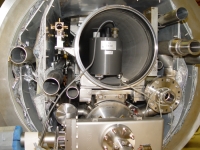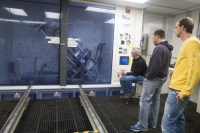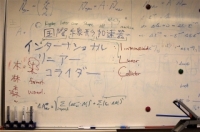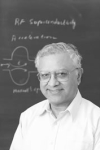Spotting the Movers and Shakers

A seismometer inside the helium gas return pipe |
Not all vibrations are good. With their 600 nanometres in width and only 6 nanometres in height, the ILC's particle beams could easily be veered off course if parts in the accelerating modules, for example the final focus quadrupole, moved by only a few nanometers. Monitoring and feedback systems will make sure that this doesn't happen, but it's even better to identify weak - moving - points and eliminate them from the very beginning. The vibration studies group is attaching seismic sensors and geophones to many different bits of modules in as many configurations as possible to figure out where the moving targets are. This work is part of the EuroTeV programme work package 'metrology and stabilisation'.
Read more...
-- Barbara Warmbein |
 |
|
|
 |
Upcoming meetings, conferences, workshops
SiD Fermilab Workshop
Fermilab, Batavia, Illinois
9-11 April 2007
The LHC Early Phase for the ILC
Fermilab, Batavia, Illinois
12-14 April 2007
TESLA Technology Collaboration Meeting
Fermilab, Batavia, Illinois
23-26 April 2007
MAC Meeting
Fermilab
26-27 April 2007
DOE/NSF ILC Americas Regional Team Review
Fermilab
30 April - 2 May
ILC Software and Tools Workshop
LAL - Orsay
2-4 May 2007
CALICE Collaboration Meeting
Kobe University, Kobe, Japan
10-12 May 2007
Annual WILGA Conference
Warsaw University of Technology Resort, Poland
21-27 May 2007
 LCWS 2007 LCWS 2007
Hamburg, Germany
30 May - 4 June 2007
View Full Calendar...
|
|
 = Collaboration-wide Meetings = Collaboration-wide Meetings
GDE Meetings Calendar |
|
|
 |
From Jefferson Lab News: Jefferson Lab Cooks Up the Perfect Cavity

John Mammosser (JLab), Cristian Boffo and Damon Bice (Fermilab) watch the cavity during an electropolishing session at JLab in December. (Photo credit: Greg Adams, Jefferson Lab) |
While it's said that opposites attract, particle physicists are taking no chances. In hopes of learning what the universe is made of, they're preparing to build a machine that will accelerate and smash together electrons and their opposites, positrons, 14,000 times every second. Like Jefferson Lab's Continuous Electron Beam Accelerator Facility (CEBAF), the proposed new machine, the International Linear Collider (ILC), is being designed to use superconducting radiofrequency (SRF) cavity technology.
Read more...
-- Kandice Carter, JLab |
 |
|
|
 |
|

During a thank-you party last week at DESY, thrown for the Calorimeter team at DESY by the Asian ECal team, who are currently using the testbeam, it became clear that even the language of math isn't universal. Compare the way Italians use their fingers to count with the way it is done in Japan: they might end up with four beers when they thought they ordered one! The Asian team also gave a crash course in katakana, the Japanese phonetic writing, and kanji, symbolic characters of Chinese origin. According to them, accelerator translates as 'add-velocity-machine.'
View Slideshow
|
 |
|
|
 |
From BBC World Service - Discovery
21 March 2007
Four programmes from Tsukuba Science City, Japan
In the first of four programmes, Richard Hollingham reports from Tsukuba Science City in Japan. Established in 1963, Tsukuba is home to more than forty of Japan’s major science research institutes.
(Audio is available on the web through 28th March)
Read more... |
|
From SLAC Today
20 March 2007
Protecting Against Electromagnetic Interference
By placing electronics from the retired SLAC Large Detector (SLD) next to a test beam in End Station A, a small group of experimenters is learning how to protect the detector electronics of the proposed International Linear Collider (ILC).
Read more... |
|
From New York Times
20 March 2007
The Scientific Promise of Perfect Symmetry
It is one of the most symmetrical mathematical structures in the universe. It may underlie the Theory of Everything that physicists seek to describe the universe.
Read more... |
|
From Die Zeit
15 March 2007
Forschung im Korsett
Doch wenn Politiker Geld geben, wollen sie auch mitreden. Sie bestimmen den ökonomischen Nutzen und die gesellschaftliche Relevanz von Forschung.
Read more... |
|
|
 |
 |
|
|
 |
ILC Baseline Alternative: The Re-entrant Cavity
ILC R&D on superconducting RF technology is of special importance because it represents

Hasan Padamsee, leader of the Cornell superconducting RF R&D group |
our central technology, and it is an area where we are forging the way for future accelerators that will employ this forward-looking technology. In addition to the high-priority demonstrations of the achievable gradient for our baseline TESLA-shape cavities, we are pursuing a broad R&D programme on alternatives that should lead to improved cavities.
Our programme includes work on single crystals, on large grain materials and on alternative shapes to the baseline. One such alternate shape is the re-entrant cavity that promises higher gradients than the TESLA cavities. In fact, two different new shapes have already achieved higher gradients in early, mostly single-cell tests. Although it will take time to develop these alternative shapes to the point where we can produce 9-cell cavities, we fully expect this will be feasible by the time we are ready to upgrade the ILC to 1 TeV, if not before.
Optimising the cavity shape and fabrication processes for high-gradient cavities turns out to be very complicated. Therefore we have supported a vigorous programme on this subject, and this past week our ILC R&D has chalked up another impressive milestone! Hasan Padamsee announced that, in collaboration with KEK, his group at Cornell has achieved a new world-record accelerating field of
Eacc = 57 - 59 MV/m for a single cell superconducting niobium cavity.
Read more...
-- Barry Barish
Director's Corner Archive |
 |
|
|
 |
|
ILC-Related Preprints
hep-ph/0703212
20 Mar 2007
Anomalous Higgs Couplings in the
SO(5) x U(1)B-L Gauge-Higgs Unification in Warped Spacetime
hep-ph/0703207
20 Mar 2007
Jets from Massive Unstable Particles: Top-Mass Determination
hep-ph/0703173
16 Mar 2007
Strategy to measure the Higgs mass, width and invisible decays at ILC
hep-ph/0703166
15 Mar 2007
Diffractive production of two ρ0L mesons in e+e– collisions
hep-ph/0703164
15 Mar 2007
The Strongly-Interacting Light Higgs
|
|

